
Datura is a genus of nine species of highly poisonous, vespertine-flowering plants belonging to the nightshade family (Solanaceae). They are commonly known as thornapples or jimsonweeds, but are also known as devil's trumpets or mad apple. Other English common names include moonflower, devil's weed, and hell's bells. All species of Datura are extremely poisonous and psychoactive, especially their seeds and flowers, which can cause respiratory depression, arrhythmias, fever, delirium, hallucinations, anticholinergic syndrome, psychosis, and death if taken internally.
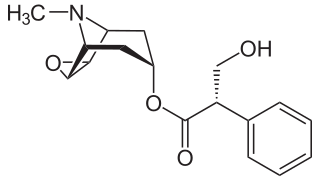
Scopolamine, also known as hyoscine, or Devil's Breath, is a natural or synthetically produced tropane alkaloid and anticholinergic drug that is used as a medication to treat motion sickness and postoperative nausea and vomiting. It is also sometimes used before surgery to decrease saliva. When used by injection, effects begin after about 20 minutes and last for up to 8 hours. It may also be used orally and as a transdermal patch since it has been long known to have transdermal bioavailability.

Atropa belladonna, commonly known as belladonna or deadly nightshade, is a toxic perennial herbaceous plant in the nightshade family Solanaceae, which also includes tomatoes, potatoes and aubergine (eggplant). It is native to Europe and Western Asia, including Turkey. Its distribution extends from Ireland in the west to western Ukraine and the Iranian province of Gilan in the east. It is also naturalised or introduced in some parts of Canada, North Africa and the United States.

Hyoscyamine is a naturally occurring tropane alkaloid and plant toxin. It is a secondary metabolite found in certain plants of the family Solanaceae, including henbane, mandrake, angel's trumpets, jimsonweed, the sorcerers' tree, and Atropa belladonna. It is the levorotary isomer of atropine and thus sometimes known as levo-atropine.

A besom is a broom, a household implement used for sweeping. The term is mostly reserved for a traditional broom constructed from a bundle of twigs tied to a stout pole. The twigs used could be broom, heather or similar. The song "Buy Broom Buzzems" from Northern England refers to both types of twig. From the phrase broom besom the more common broom comes. In Scotland and Bulgaria, besoms are still occasionally to be found at the edge of forests where they are stacked for use in early response to an outbreak of fire.

Henbane is a poisonous plant belonging to tribe Hyoscyameae of the nightshade family Solanaceae. Henbane is native to temperate Europe and Siberia, and naturalised in Great Britain and Ireland.
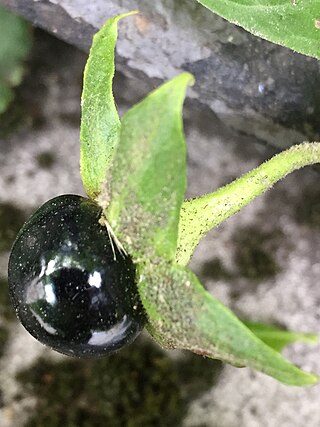
Deliriants are a subclass of hallucinogen. The term was coined in the early 1980s to distinguish these drugs from psychedelics such as LSD and dissociatives such as ketamine, due to their primary effect of causing delirium, as opposed to the more lucid and less disturbed states produced by other types of hallucinogens. The term generally refers to anticholinergic drugs, which are substances that inhibit the function of the neurotransmitter acetylcholine.
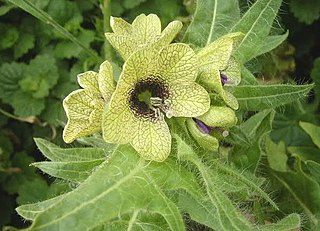
Hyoscyamus — known as the henbanes — is a genus of flowering plants in the nightshade family, Solanaceae. It comprises 31 species, all of which are toxic. It, along with other genera in the same family, is a source of the drug hyoscyamine (daturine). Cruciferous type of stomata is present in Hyoscyamus.

Tropane alkaloids are a class of bicyclic [3.2.1] alkaloids and secondary metabolites that contain a tropane ring in their chemical structure. Tropane alkaloids occur naturally in many members of the plant family Solanaceae. Certain tropane alkaloids such as cocaine and scopolamine are notorious for their psychoactive effects, related usage and cultural associations. Particular tropane alkaloids such as these have pharmacological properties and can act as anticholinergics or stimulants.

The term bane, in botany, is an archaic element in the common names of plants known to be toxic or poisonous.

Psychochemical warfare involves the use of psychopharmacological agents with the intention of incapacitating an adversary through the temporary induction of hallucinations or delirium. These agents, often called "drug weapons", are generally considered chemical weapons and, more narrowly, constitute a specific type of incapacitating agent.

Scopolia carniolica, the European scopolia or henbane bell, is a poisonous plant belonging to tribe Hyoscyameae of the nightshade family Solanaceae. It bears dark brownish-violet nodding flowers on long, slender pedicels. It grows to 60 centimetres (24 in) in height. Its toxicity derives from its high levels of tropane alkaloids, particularly atropine. The concentration of atropine is highest in the roots.

Hyoscyameae is an Old World tribe of the subfamily Solanoideae of the flowering plant family Solanaceae. It comprises eight genera: Anisodus, Archihyoscyamus, Atropa, Atropanthe, Hyoscyamus, Physochlaina, Przewalskia and Scopolia. The genera Archihyoscyamus, Atropanthe and Przewalskia are monotypic, the first being endemic to Turkey and Iran, the second to China and the third to Tibet.

The Solanaceae, or the nightshades, are a family of flowering plants that ranges from annual and perennial herbs to vines, lianas, epiphytes, shrubs, and trees, and includes a number of agricultural crops, medicinal plants, spices, weeds, and ornamentals. Many members of the family contain potent alkaloids, and some are highly toxic, but many—including tomatoes, potatoes, eggplant, bell, and chili peppers—are used as food. The family belongs to the order Solanales, in the asterid group and class Magnoliopsida (dicotyledons). The Solanaceae consists of about 98 genera and some 2,700 species, with a great diversity of habitats, morphology and ecology.
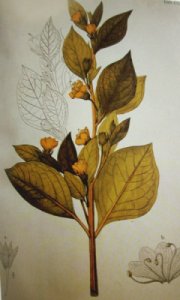
Atropa baetica, commonly known as the Andalusian belladonna, is one of Europe's rarest wildflowers. A close relative of the infamous deadly nightshade, its specific name derives from that of the Roman province of Hispania Baetica, while its common name refers to the Spanish region of Andalucía – both designating the area in the south of Spain where it is most frequently encountered. It is an attractive perennial plant with a herbaceous habit, bearing infundibuliform, yellow or greenish flowers and shiny, black berries. Like the other three species of Atropa, it is an extremely poisonous plant, containing a variety of tropane alkaloids with anticholinergic, deliriant, antispasmodic and mydriatic properties. Although most populations of the plant are to be found in Spain, it is not wholly confined to the Iberian Peninsula of Europe, occurring also in certain localities in Morocco and Algeria in the Atlas Mountains of North Africa. The Rif and the Baetic System, which face each other across the Alboran Sea, together constitute one of the finest of the Mediterranean biodiversity hotspots – rich in endemic species, of which Atropa baetica is a notable example..
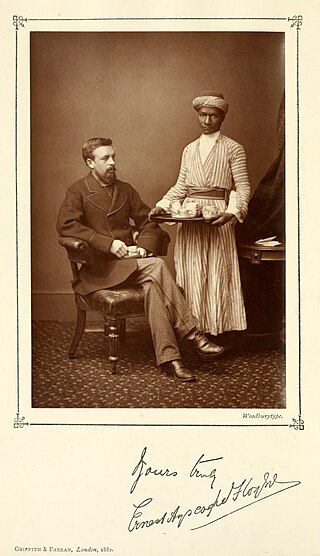
Ernest Ayscoghe Floyer (1852–1903) was a British colonial official, and explorer in Baluchistan and the Sudan. He explored the economically useful plants and materials of interest along his travels. He was put in charge of extracting nitrate of soda after discovering a deposit of it in Egypt and later served as inspector general of telegraphs in Egypt.

Physochlaina is a small genus of herbaceous perennial flowering plants belonging to the nightshade family, Solanaceae, found principally in the north-western provinces of China although one species occurs in Western Asia, while another is found as far east as those regions of Siberia abutting the eastern borders of Mongolia and, furthermore, not only in Mongolia itself, but also in the Chinese autonomous region of Inner Mongolia. Some sources maintain that the widespread species P. physaloides is found also in Japan, but the species is not recorded as being native in one of the few English-language floras of the country. The genus is a valuable one, since its species are not only of considerable medicinal value, being rich in tropane alkaloids, but also of ornamental value, three species having been grown for the purpose, although hitherto infrequently outside botanical gardens. Furthermore, the genus contains a species formerly used as an entheogen in Siberia.

Paul Flatters was a French soldier who spent a long period as a military administrator in Algeria. He is known as leader of the Flatters expedition, an ill-fated attempt to explore the route of a proposed Trans-Saharan railway from Algeria to the Sudan. Almost all members of the expedition were massacred by hostile Tuaregs. The survivors resorted to eating grass and to cannibalism on the long retreat through the desert. After a brief outburst of public indignation the fiasco was forgotten.

Bir el-Garama is a well in the south of Algeria in Tamanrasset Province, 150 kilometres (93 mi) northeast of Tamanrasset, known as the site where a large part of the French colonial Flatters Expedition was wiped out by Tuaregs. It is better known on French maps by its Tamahaq language name: Tagmout T-an Koufar, or 'well of the foreigner'.

















